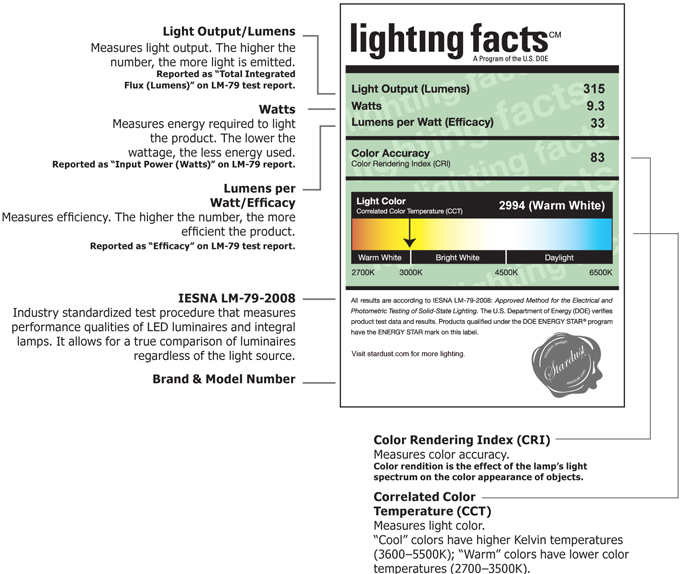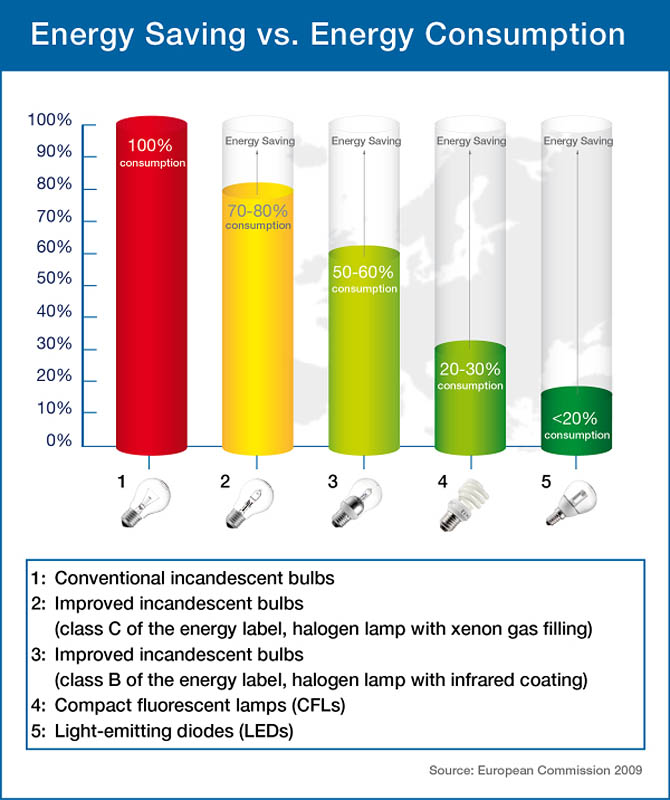Light Bulb
Stardust.com Lighting Guide: make the right lighting choice when choosing a light bulb.
Light Bulb Comparison: Comparing CFL, Halogen, Incandescent and LED.
Light Bulb Selection
How to Choose the Right Light Bulb with so many choices? With a seemingly endless range of possibilities, choosing the right bulb can be a challenge. The flurry of products, including incandescent, halogen, compact-fluorescent and LEDs, is a result of legislation passed in 2007 that requires general-purpose bulbs, to be at least 25% more efficient than those using standard incandescent technology invented by Thomas Edison in 1879. Read our lighting tutorial below to help clarify your options.Light output (measured in "lumens" or "lm")
Perhaps the most important consideration should be the lumens as it measures the amount of light a bulb emits. Measuring the performance of a lamp in lumens allows direct comparisons of light quantity (which is the service actually offered by the lamp). Comparisons based on wattage are not meaningful any more and can be misleading. Most desk lamps in office require a minimum of 700 lumens, preferably even higher. If you are used to a 100W incandescent light bulb for your reading lamp, you should look for a 1300-1530 lumens light bulb. Small table lamps or bedside lamps that are used to provide atmosphere lighting are fine between 200 and 810 lumens. Here's a quick light bulb comparison reference:220-250 lumens compares to a 25W incandescent bulb.
410-470 lumens compares to a 40W incandescent bulb.
700-810 lumens compares to a 60W incandescent bulb.
920-1060 lumens compares to a 75W incandescent bulb.
1300-1530 lumens compares to a 100W incandescent bulb.
Color Temparature of the light (measured in "K")
The second most important feature of the light bulb is the color temperature. While incandescent bulbs mostly provide the same light color ("warm white"), compact fluorescent lamps and LEDs offer a wider range of color temperatures (measured in "K", short for Kelvins). These differences are useful in certain applications. Choose 2700K or "warm white" for relaxing and more than 4000K or "cold white" for work. Please note that this is based on your personal preference. The offices of Stardust are all outfitted with warm LED's because they create a more soft light that more closely resembles halogen or incandescent. For hospitality and F&B lighting applications, we recommend Warm White to reproduce the home comfort feeling. For retail lighting application both Warm White and Natural White are suitable. Day Light color temperature is only used in office lighting and working environment applications where focus and productivity is most important. Furthermore, LED lighting output improves as color temperature is increased. The same LED will have a greater lighting output at 6500K than 3000K, which is why it is important to consider color temperature when comparing two LED sources.Color Reproduction – Color Rendering Index (measured in CRI or Ra)
CRI measures the ability of a light source to accurately reproduce colors and is measured on a scale from 0 to 100. Natural light has a CRI of 100 and is what all light sources strive to replicate. A CRI of 65 is considered poor while a CRI of 80 is considered good. Halogen and Incandescent sources have CRIs close to 100 while fluorescent sources are usually around 80. ENERGY STAR requires a CRI of 80 for integral LED lamps.How to Read the Label

Dimming Ligth Bulbs
Before you select a lamp, ask yourself if you would like to use a dimmer. You should always verify if CFL (compact fluorescent lamps) and LEDs can be dimmed, as many of them will not work when operated on standard dimmers. However, there exist also dimmable compact fluorescent lamps and LEDs, and improved incandescent or halogen bulbs are always dimmable.Light Bulb Lifespan
The lifetime of a lamp is expressed as the number of hours it will operate before dying. The average use of a lamp is 1,000 hours a year, which is based on the assumption of 3 burning hours per day on average. Lamps that are on constantly will die faster, those rarely used will last longer. With some compact fluorescent lamps, the number of times the lamp is switched on and off also influences how long they live in practice (see "Number of switches before failure"). The lifetime of lamps can vary between 1,000 hours for conventional incandescent bulbs to 15,000 hours for the best compact fluorescent lamps and LED lamps. Longer lamp life means less trouble buying and changing lamps. It should be taken into account also when comparing the price tags of the different alternatives.Light Bulb Warm-up times
Incandescent, halogen and LEDs light up with the switch of the button. But standard compact fluorescent lamps take a bit longer to start and to reach their full light output than other lamp technologies (up to 2 seconds to start and up to 60 seconds to reach 60% of their light output). However, there exist dedicated compact fluorescent lamps that are almost as fast to switch on as other lamp types (such as improved incandescent bulbs).Light Bulb dimensions
When you switch from one lamp technology to another in the same luminaire, do not forget to check whether the new lamp will fit into the luminaire before you buy it.Light Bulb Disposal
Compact fluorescent lamps and LEDs contain complex electronics. Like a regular fluorescent bulb, a compact fluorescent lamp (CFL) furthermore also contains trace amounts of mercury. These light bulbs should not be placed in the normal household waste. They should be returned to one of the shops selling them or into any other dedicated collection system for waste electronic equipment (check your local disposal location).Light Bulb Graph
This light bulb comparison graph below shows the energy savings and consumption of different types of light bulbs. Column 1 stands for conventional incandescent bulbs, column 2 and 3 for C- and B-class improved incandescent bulbs (with integrated halogen capsules), column 4 for compact fluorescent lamps (CFLs) and column 5 for light-emitting diodes (LEDs).
When you're shopping for light bulbs, compare lumens and use the Lighting Facts label to be sure you're getting the amount of light, or level of brightness, you want. You can also visit the department of energy for more information: energy.gov
We include light bulbs whenever possible:
What good is a lamp without a bulb?
That's the question we asked ourselves since most other lighting retailers will never include the (much needed) light bulb. Stardust.com has therefore taken the initiative to include the corresponding light bulb for most lamps in your order, complimentary! This sets us apart from other retailers who in most cases will never include a light bulb. That may not sound like a big deal but a lot of the lamps we sell require special light bulbs which can sometimes be time consuming to find. We are pretty sure that you are busy enough already and that you will appreciate the additional service from Stardust.com. So no need to look for a light bulb when you order a lamp through Stardust.com, we will include it with your order, free of charge!
Please note that Stardust.com may order the light bulb through a third party light bulb vendor. Light bulb(s) will arrive separately since they will be shipped from a separate warehouse. Please allow additional time for light bulb(s) to arrive.
We suggest the following websites for customers who are looking for additional spare light bulbs:
bulbs.com
1000bulbs.com
bulbman.com